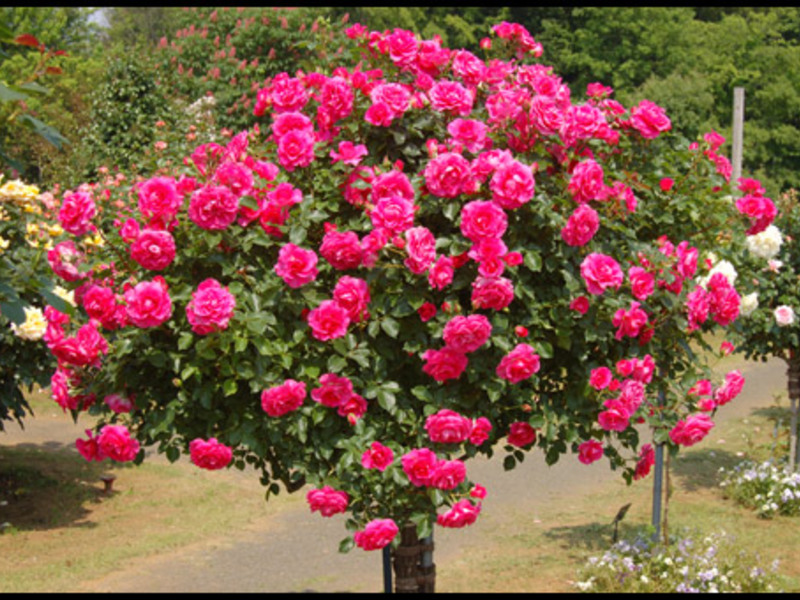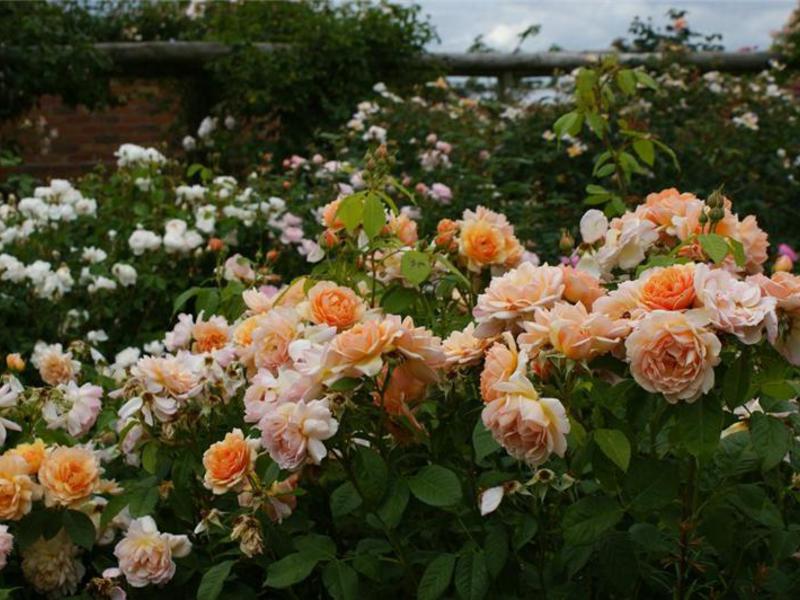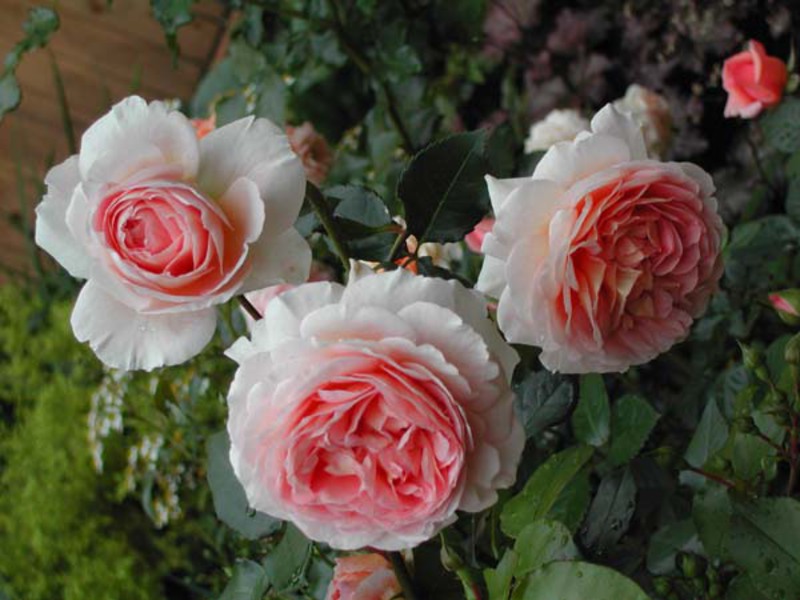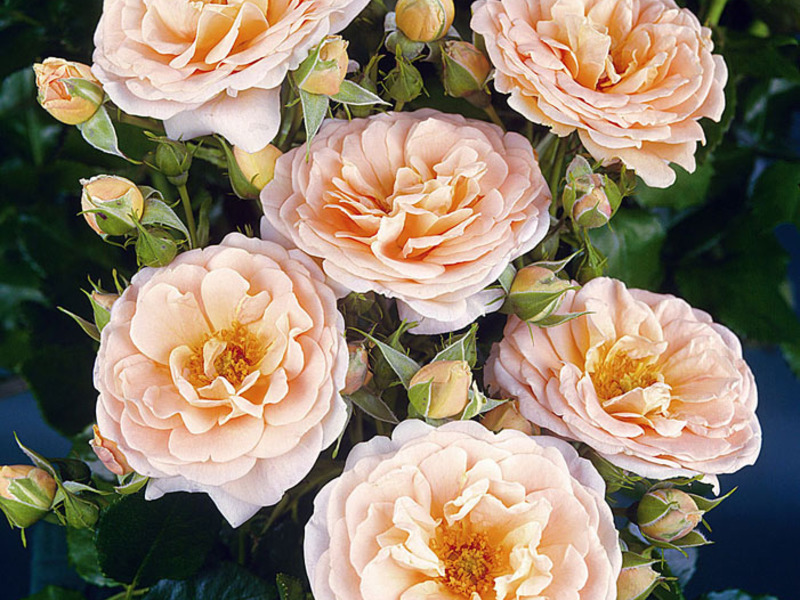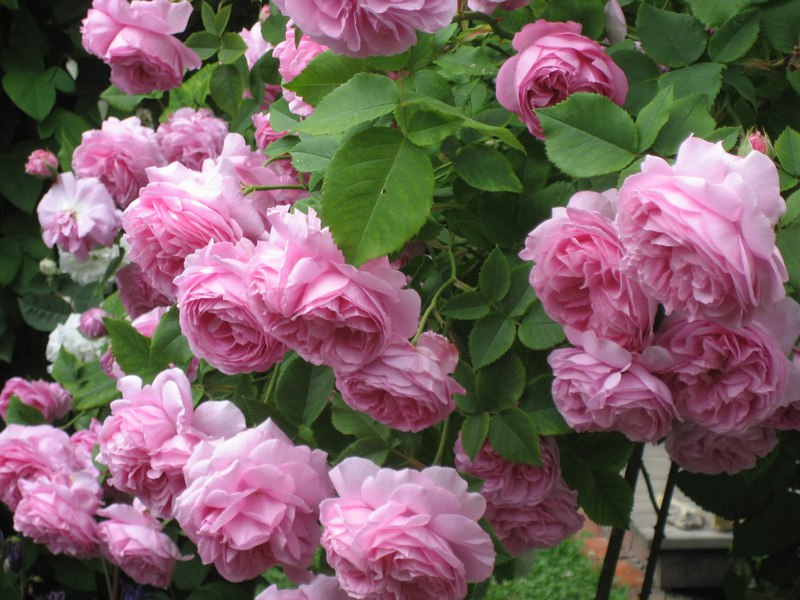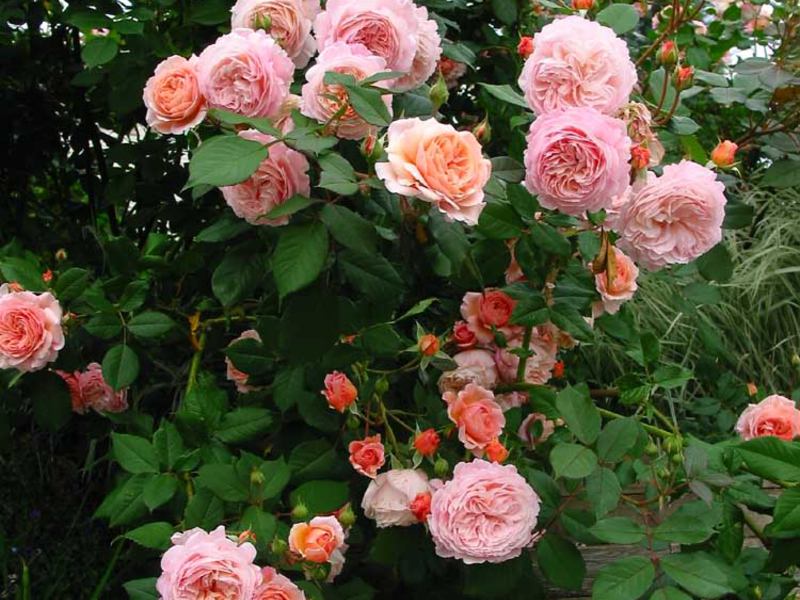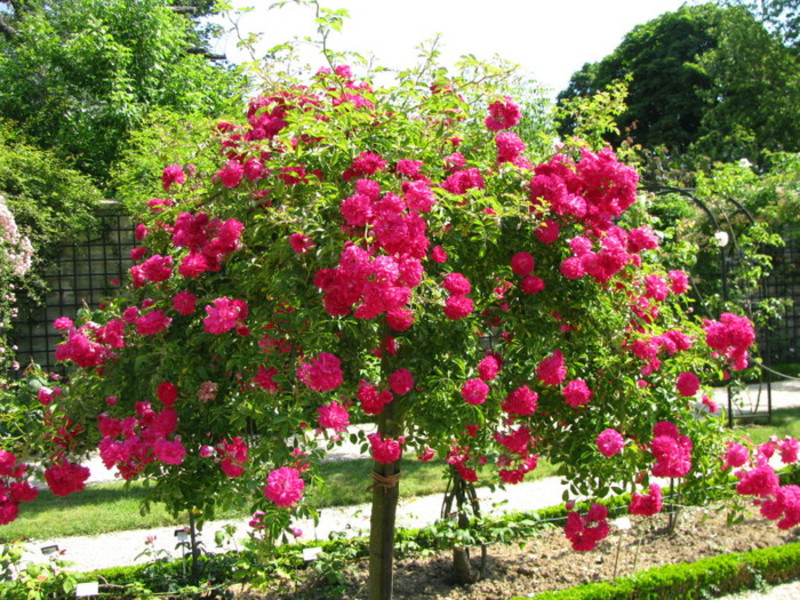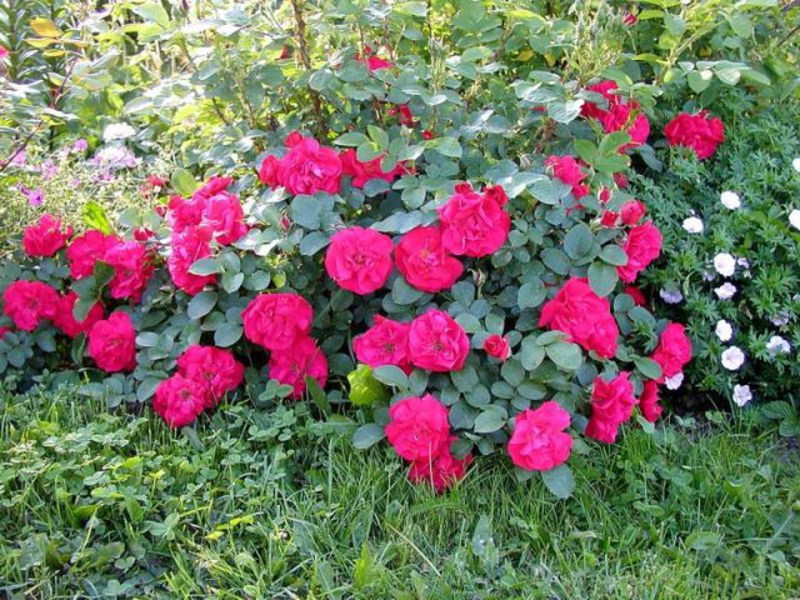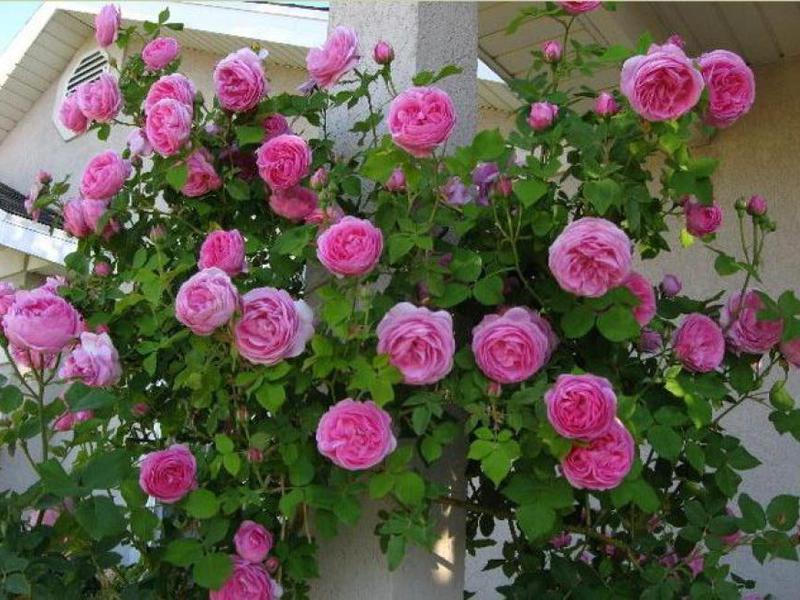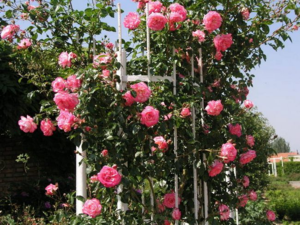The rose is traditionally considered the queen of flowers. Amazing color variety, unique aroma, stunning beauty of the buds - all this allows her to fully correspond to such a high title. City parks and flower beds, wedding bouquets and decor are unthinkable without it, and a delicate pink scent has long inspired perfumers.
Content
From the history of the rose
 It is difficult to say when for the first time a real rose was bred from a modest wild rose, but already in Babylon and Persia this flower was very revered.
It is difficult to say when for the first time a real rose was bred from a modest wild rose, but already in Babylon and Persia this flower was very revered.
From the East rose bushes ended up in Greece and Rome... Greek myths have preserved references to the white and red rose as the flower of Aphrodite. It was highly revered in Greece both as a garden plant and as a plant used for garlands at celebrations and religious ceremonies. Descriptions of flowers with 20 or even hundreds of petals have been preserved.
It is not known whether the rose came to Rome from Greece or directly from the East. The frescoes in Pompeii depict its Damascus variety, which speaks in favor of the second version. On the other hand, as in Greece, the rose was part of the cult of Venus (Aphrodite).
With the fall of the Roman Empire, many of her achievements and knowledge were lost. They were partially preserved only in monasteries, where gardening, including the cultivation of roses, was preserved along with Latin and book science. In the early Middle Ages, preference was given to the cultivation of fruit, medicinal plants and spices, and wildflowers were used for wreaths. The queen of flowers was practically the only exception to the rule.
This was facilitated by special flower statuswhich the Catholic Church endowed him with. It symbolized purity and holiness and was closely associated with the cult of the Virgin and the suffering of Jesus Christ. Fragrant flowers were also common in commemoration rites - rosals borrowed from the ancient Romans and celebrated during their mass flowering in May.
After the capture of Constantinople and the Crusades, previously unknown varieties appear in Europe. The rose is grown in the episcopal and royal gardens. It is widely used in architecture and in medieval heraldry as a symbol of impeccability and perfection.
At the turn of the 18-19 centuries. new thermophilic Asian varieties were brought to Great Britain and France. They were distinguished by dense shiny leaves, amazing delicacy of the bud and the ability to bloom many times over a long time. True, such roses were completely not adapted to harsh European winters... For many years, European breeders have tried to resolve this contradiction. The task seemed impossible for a long time, and only in the 19th century. managed to cross two types of roses, which led to a real breakthrough in rose growing and the emergence of modern hybrid tea species.
Classification of roses
There are tens of thousands of pink varieties and hybrids in the world. To understand all this diversity and to organize it, many classifications have been created. For example, in some catalogs, roses are distinguished by the number of petals. Allocate:
- simple (there are a maximum of 7 petals in the bud);
- semi-double (in flowers from 8 to 20 petals);
- terry (more than 20).
 There are also roses park and garden... Ornamental varieties and hybrids of rose hips, suitable for breeding in a harsh climate without or with a light winter shelter, are considered to be parks. Gardening includes various varieties of continuously or repeatedly flowering subtropical roses and their hybrids obtained as a result of long-term selection. They require special care and good shelter for the winter.
There are also roses park and garden... Ornamental varieties and hybrids of rose hips, suitable for breeding in a harsh climate without or with a light winter shelter, are considered to be parks. Gardening includes various varieties of continuously or repeatedly flowering subtropical roses and their hybrids obtained as a result of long-term selection. They require special care and good shelter for the winter.
However, most often they use another classification adopted by the World Federation of Rose Societies. It is she who is found in catalogs of descriptions of varieties of roses with photos and names. This classification is not based on origin, but on their sustainable decorative and biological characteristics. Accordingly, there are old and modern garden roses.
Old garden roses
The old varieties are those bred before the appearance in the 19th century. tea-hybrid roses and did not undergo any changes after that. Usually these are shrubs that have lost the resemblance to rose hips. They are resistant to diseases and were not initially capable of repeated flowering. But after the appearance in Europe of tea roses from Southeast Asia, hybrids appeared that bloom from spring to autumn.
Old varieties represented by many different groups. Here is some of them:
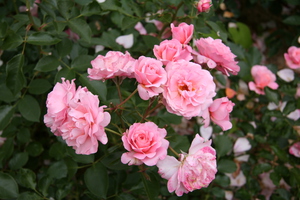 Alba roses, or white roses, - tall upright bushes with white or pinkish double flowers, resistant to disease and cold. They bloom profusely once a year. This ancient variety was known as early as the 14th century. It is he who is depicted on the coat of arms of Yorks.
Alba roses, or white roses, - tall upright bushes with white or pinkish double flowers, resistant to disease and cold. They bloom profusely once a year. This ancient variety was known as early as the 14th century. It is he who is depicted on the coat of arms of Yorks.- Bourbon roses were brought to France from the Bourbon Island in the Indian Ocean. These are remontant shrubs with thick shoots, shiny oval leaves and fragrant double flowers of pink, white or red. There are both erect and climbing varieties.
- Centifolaceous (colloidal, or Provencal) roses first appeared in Holland. The plant is bushy, low, but spreading, with thorns and double flowers and a characteristic odor. The color range ranges from white to deep pink. Less common, and therefore highly prized, yellow, striped or spotted varieties. They bloom profusely, once a season.
- Damask roses appeared in the Middle East in time immemorial by natural selection. They were bred by the ancient Romans, and in the 13th century. the crusaders brought it in again. The bushes are tall, with drooping shoots and thorns. Flowers are double, fragrant. Shades range from light pink to red. The famous rose oil is produced from the Kazanlak variety of Damask rose in Bulgaria. For a long time, only a few old varieties could bloom again, including "Autumn Damask".
- Gallica rose hybrids descended from the Gallic rosehip. This is a very old European variety. Some of its varieties were grown at monasteries as medicinal plants. They are undersized spreading shrubs. The flowers are fragrant, simple or densely double, pink, red, purple, crimson or striped.
- Have moss roses strongly pubescent shoots and sepals. Due to the special glandular hairs emitting a specific woody smell, it seems that they are covered with moss. The plant looks like a low or medium-sized shrub. They were extremely popular in the 18th and 19th centuries. due to the ability to re-bloom. Later, their popularity declined, until in the 60s. 20th century the stunningly decorative miniature Fairy Moss has not been developed.
- Chinese roses occupy a special place in rose growing. Before their import from China and Bengal in the 18th century. in Europe, only a few varieties could bloom again. The appearance of these remontant shrubs with smooth shoots and sparse thorns, with simple or densely double flowers, immediately attracted the attention of breeders. In addition to re-flowering and exquisite small buds, they had a unique feature: they did not fade in the sun over time, unlike the old European varieties, but darkened.As a result, Chinese roses have given rise to many re-or continuously flowering varieties, such as bourbon, noisette and others.
In total there are 15 groups of old varieties.
Modern garden roses
In a simplified form, the list of modern rose varieties looks like this:
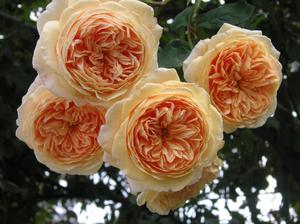 floribunda;
floribunda;- climbing (ramblers and climbers);
- ground cover;
- tea-hybrid;
- scrubs;
- miniature.
Floribunda externally resemble hybrid tea, but differ in longer, and sometimes continuous, flowering and better winter hardiness. Often fragranceless. Simple, semi- or densely double flowers are collected in bouquet-type inflorescences. The buds can be of very different shapes - in the form of a bowl or a glass. Both the size of the bush (from dwarf to high) and the color range differ in a wide variety. Varieties: Blue for you, Lions-rose, Pomponella (photo).
Climbing grow from two to four m in length. Their flowers are collected in inflorescences. Ramblers have flexible climbing stems that need support and flowers that are smaller than climbers. They bloom once, but very profusely. Climbing Climbers are distinguished by their thick stems, large flowers and continuous flowering. Varieties: Elfe, Jasmina, Michka.
Ground cover varieties descended from the climbing variety of old garden roses. They either spread on the ground, or have long drooping shoots, or the width of this bush plant simply exceeds its height. Flowers are medium-sized, of a wide variety of shades. This type of rose fits easily into any landscape design and goes well with other plants. Varieties and photos: Euphoria, Purple Rain, Satina.
The most popular and most decorative group are tea-hybrid. Large double and double buds have a classic shape, continuous flowering and amazing color variety. Gamma ranges from white to almost black (in fact, we are talking about rich red). Their aroma is varied. It can be light, subtle, or thick and rich. The varieties of this group have very eloquent names and are widely represented in all flower catalogs: Advance, Black Baccara, Topaz, Hommage a Barbara, Wow, Papillon.
